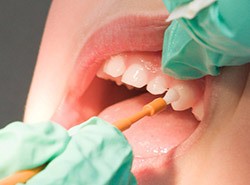In an age where health consciousness is paramount, dental hygiene remains a cornerstone of overall well-being. However, emerging trends and persistent habits pose significant threats to oral health, particularly among younger generations. While traditional dental care emphasizes brushing, flossing, and regular check-ups, it’s increasingly vital to understand the detrimental effects of new habits like vaping on teeth. Concurrently, preventive measures, such as professional fluoride treatment for kids, continue to play a crucial role in building resilient smiles from an early age, offering a protective shield against various oral health challenges, including those exacerbated by modern lifestyle choices.
The Rising Concern: Effects of Vaping on Teeth
Vaping, often marketed as a safer alternative to traditional cigarettes, has surged in popularity, especially among adolescents and young adults. However, accumulating scientific evidence highlights significant adverse effects of vaping on teeth and overall oral health. Unlike traditional smoking which involves tar, vaping introduces a cocktail of chemicals, including nicotine, propylene glycol (PG), vegetable glycerin (VG), and various flavorings, directly into the oral cavity.
One of the most common and immediate effects of vaping is dry mouth, also known as xerostomia. Ingredients like propylene glycol are humectants, meaning they draw moisture from the surrounding tissues, leading to reduced saliva flow. Saliva is the mouth’s natural defense mechanism, neutralizing acids, washing away food particles, and aiding in remineralization. A persistent dry mouth significantly increases the risk of tooth decay, gum disease, and bad breath.
Beyond dry mouth, vaping directly contributes to an increased risk of tooth decay and cavities. Nicotine and the sugary, sticky nature of many vape juices create an ideal environment for harmful bacteria to thrive. These bacteria metabolize sugars to produce acids that erode tooth enamel, the protective outer layer. Furthermore, ingredients like vegetable glycerin, when combined with flavorings, can enhance bacterial adhesion to tooth surfaces and promote biofilm formation, making teeth more susceptible to acid attacks and subsequent cavities. Some studies also suggest that propylene glycol breaks down into acidic byproducts, further weakening enamel.
Vaping also poses a direct threat to gum health, increasing the risk of gingivitis and periodontitis. Nicotine, a potent vasoconstrictor, reduces blood flow to the gums, depriving them of essential oxygen and nutrients needed for healing and fighting infection. This compromised blood supply makes gums more vulnerable to inflammation, bleeding, and eventual recession. Chemicals in vape vapor can also directly irritate gum tissue. Moreover, vaping disrupts the delicate balance of the oral microbiome, favoring the proliferation of pathogenic bacteria associated with gum disease while diminishing beneficial bacteria. This imbalance further exacerbates the risk of inflammation and infection.
Other noticeable effects include tooth discoloration and staining. While less severe than from traditional cigarettes, nicotine and certain flavoring chemicals in vape juices can cause yellow or brown stains on teeth over time. Concerns also exist about changes in the oral mucosa, the soft tissues lining the mouth. Vaping can cause irritation, inflammation, and even mouth sores or ulcers, with some studies exploring a potential, though not yet conclusive, link to cellular changes that could increase oral cancer risk. The combination of these factors paints a clear picture: vaping is far from harmless for oral health.
Building Resilient Smiles: The Power of Fluoride Treatment for Kids
Given the growing prevalence of oral health challenges, including those posed by vaping, preventive dental care is more critical than ever. Among the most effective preventive measures is professional fluoride treatment for kids. Fluoride is a natural mineral that plays a vital role in strengthening tooth enamel, making it more resistant to acid attacks caused by bacteria and sugars. For children, whose teeth are still developing, fluoride is exceptionally beneficial.
The importance of fluoride treatment for kids cannot be overstated. It works in multiple ways to safeguard young smiles. Firstly, it strengthens tooth enamel by integrating into the tooth structure, making it harder and more resilient. This process, known as remineralization, helps to replenish minerals lost due to acid attacks, effectively reversing early signs of tooth decay before they become full-blown cavities. Secondly, fluoride has an antimicrobial effect, helping to control the growth of harmful bacteria in the mouth that produce decay-causing acids.
Professional fluoride treatment for kids is a quick, safe, and painless procedure, typically applied during routine dental check-ups. The dentist applies a highly concentrated form of fluoride—usually as a varnish, gel, or foam—directly onto the child’s teeth. The process takes only a few minutes, after which children are usually advised to avoid eating or drinking for a short period (e.g., 30 minutes) and refrain from brushing for a few hours to allow the fluoride to fully absorb and work its magic.
Regular applications, often recommended every three to six months depending on the child’s cavity risk, provide continuous protection, supplementing the fluoride received from fluoridated water and toothpaste. This targeted approach is particularly important for children who may not be getting sufficient fluoride otherwise or those who are more prone to cavities due to diet or less refined brushing habits. By protecting primary (baby) teeth, fluoride also helps ensure proper spacing for permanent teeth to erupt correctly, preventing future orthodontic issues. Investing in fluoride treatment for kids from an early age can significantly reduce the need for more extensive and costly restorative dental procedures later in life, ultimately saving money and discomfort.
conslusion
maintaining optimal oral health requires a multi-faceted approach. While the detrimental effects of vaping on teeth highlight the need for greater awareness and cessation efforts, the foundational role of preventive treatments like fluoride treatment for kids remains indispensable. By understanding the risks posed by habits like vaping and actively embracing proven preventive strategies, individuals and parents can ensure stronger, healthier smiles for a lifetime. Regular dental check-ups, good oral hygiene practices, and professional fluoride applications are crucial steps in building a robust defense against dental decay and ensuring a brighter, healthier future for every smile.













































